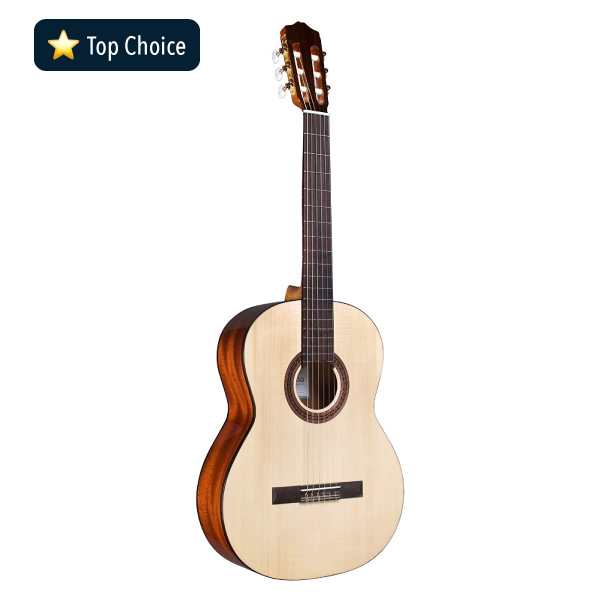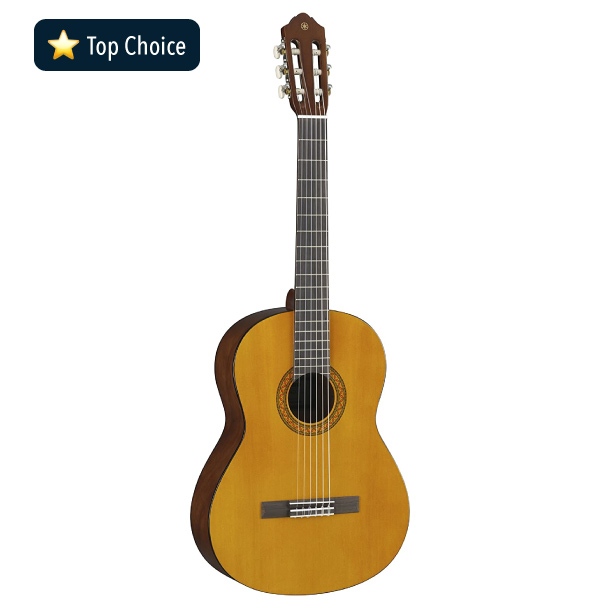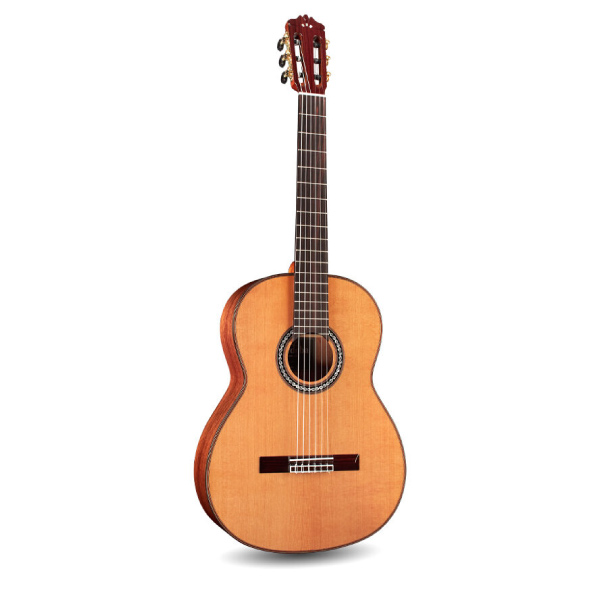If you want to start learning classical guitar, the first step is choosing the right instrument! Choosing the right guitar can significantly impact your learning experience and musical progress. In this guide, my goal is to provide beginners with comprehensive advice on selecting the best classical guitars at an affordable price.
Scroll below to explore guitars by education level or price. As a result, you’ll get the best value for your money, and feel confident as you learn!
Top Student Level Guitar Recommendations
If you don’t want to read too much or shop around, here’s my top recommendations:
- Overall Best Beginner Guitar Model: Cordoba C5 (Spruce or Cedar top)
- Best Beginner Guitar for the Lowest Price: Yamaha C40II



The guitars mentioned in this article are available for online purchase and can be conveniently delivered to your doorstep. Given that trying out the guitar in a physical store may not be feasible, I’ve carefully selected the best guitar brands and models that consistently deliver quality on a large scale.
My recommendations are grounded in my own experiences with these instruments, as well as the insights and feedback received from my students and online community.
If there’s other models or brands you think I should check out, please leave a comment and let me know!
By Guitar Level
Not ready to invest thousands of dollars on a custom-built guitar by a luthier? Don’t worry! There are excellent student-level options that provide good quality at various price points.
Top Brand Picks: Cordoba, Yamaha, and Alhambra brands consistently deliver quality and value. You can also visit my Classical Guitar Shop page with links to browse even more models.
- Entry Level: I recommend the Cordoba C5, C7, or C9 models. The higher numbers indicate better quality. But if you’re on a tight budget, the Yamaha C40II or Yamaha CG102 are also solid options.
- Intermediate: The Cordoba C10 offers a step up in quality and experience.
- Late-Intermediate: Consider the Cordoba C12 for higher quality wood, a hand inlaid Mother-of-Pearl “Esteso” Rosette, and superior craftsmanship. I also like the guitars from the late Wolfgang Jellinghaus factory.
- Advanced: You’re probably ready for a guitar crafted by a single luthier, which represents the pinnacle of personalization and quality. I recommend you explore the high-end classical guitars available on Guitar Salon International or Siccas.
By Price Range
Under $250
The Yamaha C40II is a great guitar priced between $150-$200. For those on a tight budget, the C40II offers satisfactory sound and playability. That said, you might outgrow it musically sooner than later.
The Yamaha CG102 is another terrific model in the $200-$230 price range. Yamaha’s CG models use a different bracing pattern for greater resonance, though honestly it’s difficult for me to hear much difference between it and the C40II.


Under $400
The Cordoba C5, priced around $300-$350, features a solid top and is my overall top choice for beginners looking for quality without breaking the bank. You can choose either the Spruce or Cedar option:


Under $700
The Cordoba C7 has an upgraded solid cedar or spruce top and laminate Indian Rosewood back and sides in the price range of $475-$650. As a result, the C7 produces a louder and more refined sound compared to other entry-level models.


Recommended Under $1000:
Priced between $900-$1000, the Cordoba C9 model boasts a solid Canadian cedar top with solid mahogany back and sides, ideal for lasting through the intermediate years. Also available in a parlor size (7/8) for smaller players.



Recommended Under $3,000
- Cordoba C10: Priced anywhere from $1300 – $2000, the C10 features a solid Canadian cedar top and solid Indian rosewood back and sides. C10 Spruce top models are available as well.
- Cordoba C12: Available for $2000-$2300, this guitar includes modern design elements like lattice braced top and raised fingerboard for enhanced playability. Ideal for ambitious young concert players. The C12 Spruce top model is also available. Both of these listings include a Humicase for extra protection and security.
- Saers Guitar A50: At $1289, it offers great value and is comparable to the higher priced Cordoba C10.

Most of these models feature truss rods for easy neck adjustment and setup. This is a critical feature for maintaining the instrument’s playability, especially if you’re looking for a long-term entry-level guitar.
Solid tops are another must-have, as most luthiers would agree that the top wood is the most important sound-producing feature of a guitar. Cordoba models C3 and up all have solid tops as a standard feature, which therefore enhances the sound quality.
Also, If you’re interested in a flamenco or “Spanish guitar” sound, you should also check out the Cordoba Iberia Series models. The Iberia series merges traditional craftsmanship with contemporary innovations, offering exceptional value for both beginners and professionals in a nylon string guitar.
Yamaha guitars are also commendable for their build quality, though they lack truss rods, which is a minor trade-off given their overall value.
Remember, these recommendations are based on my personal experience and collective evaluations from students and other professionals. The best classical guitars for you will depend on your budget, playing level, and personal preferences. Always prioritize playability, sound quality, and comfort in your selection.
Tips for Buying a Guitar at a Shop (In-Person)
The tactile experience of holding and playing a guitar cannot be underestimated. If you live near a guitar shop that has some of these best classical guitar options, visit their store to try them in-person!
This hands-on approach is crucial, as it helps you get the feel of different guitars, their weight, the ease of fretting the strings, and the resonance of the instrument. If you live far from large cities, some dealers like Guitar Salon International offer trial periods or online consultations to help make an informed decision remotely.
Assess the quality and sound
A high-quality classical guitar is made entirely of wood, which greatly influences its sound. Entry-level guitars often incorporate cheaper materials, such as plastic. Materials like this can have a negative affect on the tone and durability of the instrument.
When examining a guitar, pay close attention to the materials used in its construction. The sound of the guitar is paramount! It should be rich, full, and pleasing to the ear. Every note should resonate well and contribute to a harmonious sound overall.
Don’t buy the cheapest available option
Remember, a good deal at a big box store might not always be the best choice. Guitars priced under $100 will probably not offer the quality or longevity you need. As a result, you’ll get frustrated with their poor tuning stability and inferior sound.
Avoid steel string acoustic brands
When it comes to buying the best classical guitars, I also don’t recommend brands like Martin, Taylor, or Ibanez. While these guitar makers are leaders in the steel string acoustic guitar industry, classical guitar construction requires a special approach.
Bring a friend
A friend who is well-versed in classical guitar can offer support and guidance during your search. Their experience can help you navigate the vast array of options and find a guitar that suits your needs and preferences.
However, ensure that the friend has a background in classical music, as the requirements for classical guitars differ significantly from those of other guitar types.
Testing the guitar yourself
For beginners, it’s advantageous to have a teacher or an experienced guitarist test the guitar. Their expertise allows them to evaluate the instrument’s sound quality and ease of play.
However, as your skills improve, your own assessment becomes more critical. You should test the guitar using various techniques, such as:
- Practice rest and free strokes: Check for any inconsistencies or defects
- Play each note across the fretboard on every string: Listen carefully for any buzzing or dead spots. A quality instrument should have even tonal quality across all strings and frets.
- Doublecheck the treble register: While bass notes typically sound robust on luthier-crafted guitars, achieving high-quality treble notes is more challenging. Look for sustain, clarity, and richness in the treble register, particularly in guitars over $500.
- Test volume and projection: Gauge the guitar’s true volume and projection by having a trusted listener assess its sound from a distance. If you’re a performer, you want to ensure it reaches the audience clearly!
Conclusion: Making Your Choice
The primary goal in selecting your first classical guitar is not to choose the most expensive or visually appealing option, but to find an instrument that feels right for you. Ultimately, the “best classical guitars” for beginners are the ones that inspires you to practice and explore the world of classical music!
With careful consideration and a bit of research, you’ll find the perfect guitar to begin your musical journey. Remember, the first guitar you choose will be a stepping stone that will serve you well as you develop your skills and express your musicality.




